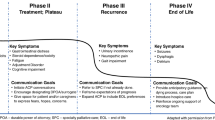Abstract
High-grade malignant glioma patients face a poor prognosis, preceded by rapid functional and neuro-behavioural changes, making multidisciplinary care incorporating supportive and palliative care important. This study aimed to quantify the association between symptoms, receipt of supportive and palliative care and site of death. We undertook a retrospective cohort study between 2003 and 2009 of incident malignant glioma cases who survived for at least 120 days between their first hospitalisation and their death (n = 678) in Victoria, Australia, using linked hospital, emergency department and death data. The median age of patients was 62 years, 40 % were female, and the median survival was 11 months. Twenty-six percent of patients died outside of hospital, 49 % in a palliative care bed/hospice setting and 25 % in an acute hospital bed. Patients having 1 or more symptoms were more than five times as likely to receive palliative care. Patients who receive palliative care are 1.7 times more likely to die outside of hospital. In conclusion malignant glioma patients with a high burden of symptoms are more likely to receive palliative care and, in turn, patients who receive palliative care are more likely to die at home.
Similar content being viewed by others
References
Schwartzbaum JA, Fisher JL, Aldape KD et al (2006) Epidemiology and molecular pathology of glioma. Nat Clin Pract Neurol 2:494–503
Tran B, Rosenthal M (2010) Survival comparison between glioblastoma multiforme and other incurable cancers. J Clin Neurosci 17:417–421
Faithfull S, Cook K, Lucas C (2005) Palliative care of patients with a primary malignant brain tumour: case review of service use and support provided. Palliat Med 19:545–550
Catt S, Chalmers A, Fallowfield L (2008) Psychosocial and supportive-care needs in high-grade glioma. Lancet Oncol 9:884–891
Pace A, Di Lorenzo C, Guariglia L et al (2009) End of life issues in brain tumor patients. J Neurooncol 91:39–43
Oberndorfer S, Lindeck-Pozza E, Lahrmann H et al (2008) The end-of-life hospital setting in patients with glioblastoma. J Palliat Med 11:26–30
Sizoo EM, Braam L, Postma TJ et al (2010) Symptoms and problems in the end-of-life phase of high-grade glioma patients. Neuro Oncol 12:1162–1166
Australian Bureau of Statistics (2012) Australian Demographic Statistics. http://www.abs.gov.au/ausstats/abs@.nsf/mf/3101.0. Accessed 15 Aug 2012
Australian Bureau of Statistics (2004–2006) Private Health Insurance: a snapshot. http://www.abs.gov.au/ausstats/abs@.nsf/mf/4815.0.55.001. Accessed 15 Aug 2012
State Government of Victoria Australia, Department of Health (2012) Victorian Emergency Minimum Dataset (VEMD). http://www.health.vic.gov.au/hdss/vemd/index.htm. Accessed 15 Aug 2012
State Government of Victoria Australia, Department of Health (2012) Victorian Admitted Episodes Data Set (VAED). http://www.health.vic.gov.au/hdss/vaed/index.htm. Accessed 15 June 2012
State Government of Victoria Australia, Department of Justice (2012) Victorian Registry of Births, Deaths and Marriages www.bdm.vic.gov.au. Accessed 24 April 2012
Henderson T, Shepheard J, Sundararajan V (2006) Quality of diagnosis and procedure coding in ICD-10 administrative data. Med Care 44:1011–1019
State Government of Victoria Australia, Department of Health (2012) Victorian Data Linkages. http://www.health.vic.gov.au/vdl/
Organisation of World Health (2012) International Classification of Diseases for Oncology, 3rd edn (ICD-O-3). http://www.who.int/classifications/icd/adaptations/oncology/en/index.html. Accessed 24 April 2012
Chang SM, Parney IF, Huang W et al (2005) Patterns of care for adults with newly diagnosed malignant glioma. JAMA 293:557–564
University of Wollongong (2012) International Statistical Classification of Diseases and Related Health Problems, Tenth Revision, Australian Modification (ICD-10-AM). http://nccc.uow.edu.au/icd10am/icd10am/index.html. Accessed 24 April 2012
Gomes B, Higginson IJ, Calanzani N, et al. (2012) Preferences for place of death if faced with advanced cancer: a population survey in England, Flanders, Germany, Italy, the Netherlands, Portugal and Spain. Annals of Oncology
Walker S, Read S, Priest H (2011) Identifying, documenting, and reviewing preferred place of death: an audit of one UK hospice. Int J Palliat Nurs 17:546–551
McNamara B, Rosenwax L (2007) Factors affecting place of death in Western Australia. Health Place 13:356–367
Hong CY, Chow KY, Poulose J et al (2011) Place of death and its determinants for patients with cancer in Singapore: an analysis of data from the Singapore Cancer Registry, 2000–2009. J Palliat Med 14:1128–1134
Burge F, Lawson B, Johnston G (2003) Trends in the place of death of cancer patients, 1992–1997. CMAJ 168:265–270
Cohen J, Houttekier D, Onwuteaka-Philipsen B et al (2010) Which patients with cancer die at home? a study of six European countries using death certificate data. J Clin Oncol 28:2267–2273
Hudson P (2003) Home-based support for palliative care families: challenges and recommendations. Med J Aust 179:S35–S37
Monroe B, Olivere D (2009) Communicating with family carers. In: Hudson P, Payne S (eds) Family carers in palliative care: a guide for health and social care professionals. Oxford University Press, New York, pp 1–20
Harding R, Epiphaniou E, Hamilton D et al (2011) What are the perceived needs and challenges of informal caregivers in home cancer palliative care? qualitative data to construct a feasible psycho-educational intervention. Support Care Cancer 20:1975–1982
Pace A, Di Lorenzo C, Capon A et al (2012) Quality of care and rehospitalization rate in the last stage of disease in brain tumor patients assisted at home: a cost effectiveness study. J Palliat Med 15:225–227
Davies E, Clarke C (2004) Early symptoms of brain tumours. J Neurol Neurosurg Psychiatry 75:1205–1206
Acknowledgments
The authors would like to acknowledge the time and expertise of the study advisory group who ensured the methodology, results, and interpretation of findings were clinically grounded: Ros Aylot, Amanda Bolleter, Dr Dianne Clifton, Dr Jeremy Couper, Dr Michael Dally, Prof Mark Rosenthal, Dr Peter Sherwen, and Jane Staker. This study was supported by translational cancer research grant [EO109_29] from the Victorian Cancer Agency of the Victorian State Government Department of Health.
Conflict of interest
The authors have declared no conflicts of interest.
Author information
Authors and Affiliations
Corresponding author
Electronic supplementary material
Below is the link to the electronic supplementary material.
Rights and permissions
About this article
Cite this article
Sundararajan, V., Bohensky, M.A., Moore, G. et al. Mapping the patterns of care, the receipt of palliative care and the site of death for patients with malignant glioma. J Neurooncol 116, 119–126 (2014). https://doi.org/10.1007/s11060-013-1263-7
Received:
Accepted:
Published:
Issue Date:
DOI: https://doi.org/10.1007/s11060-013-1263-7




